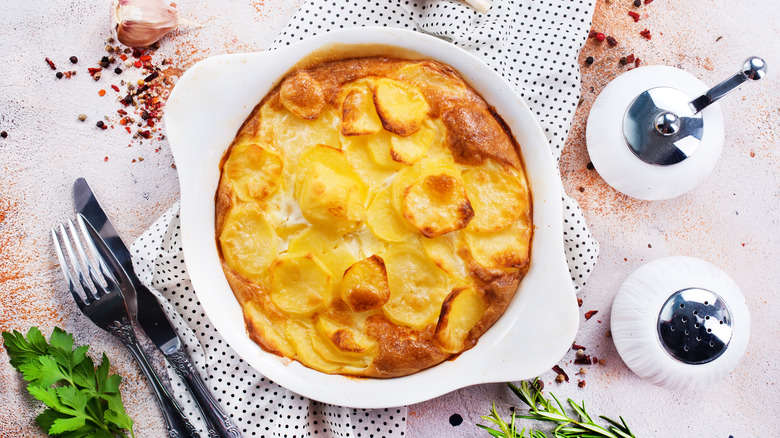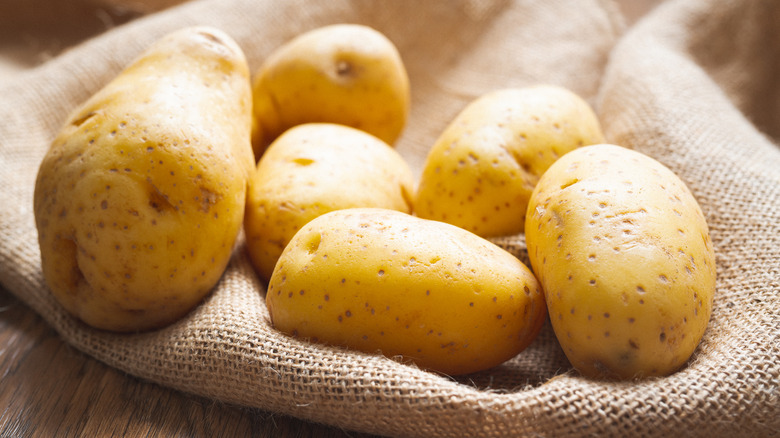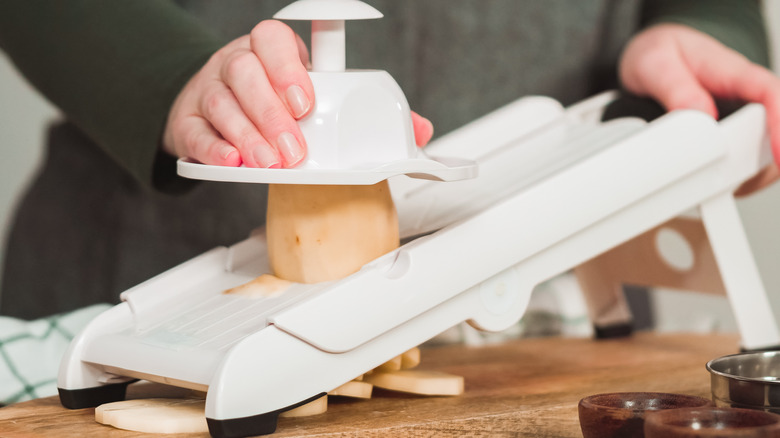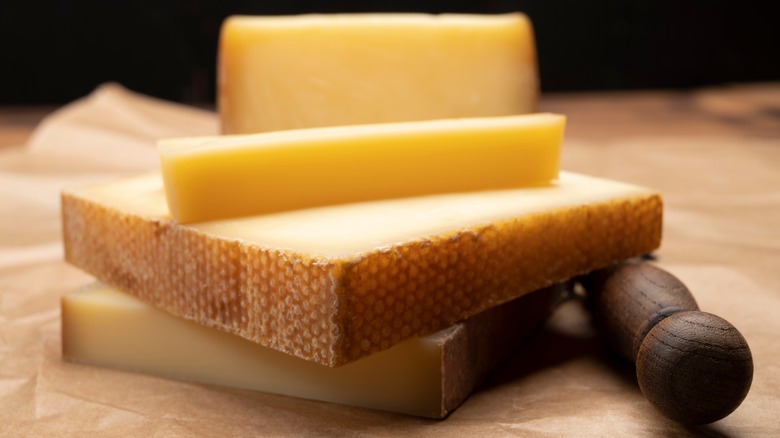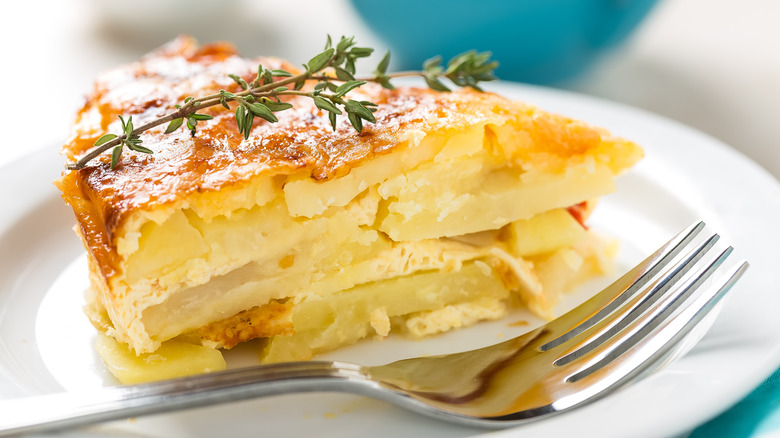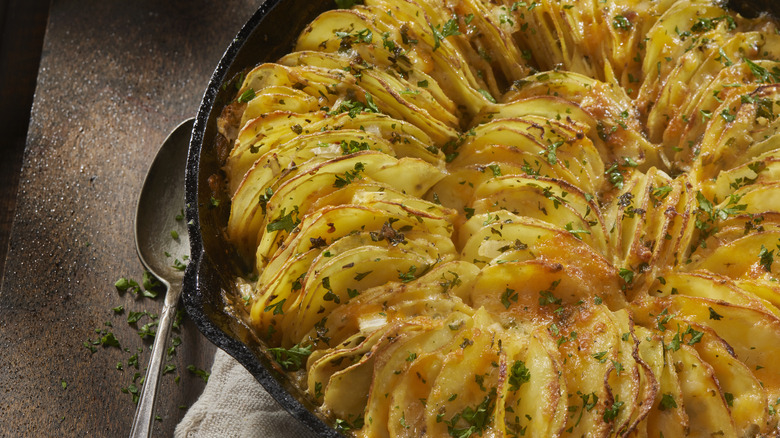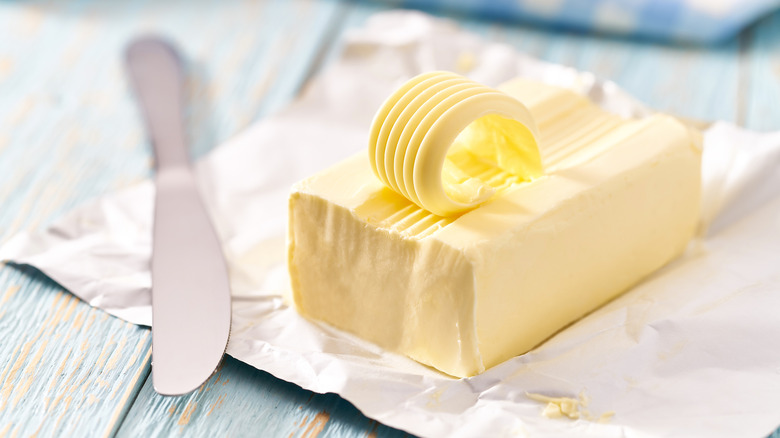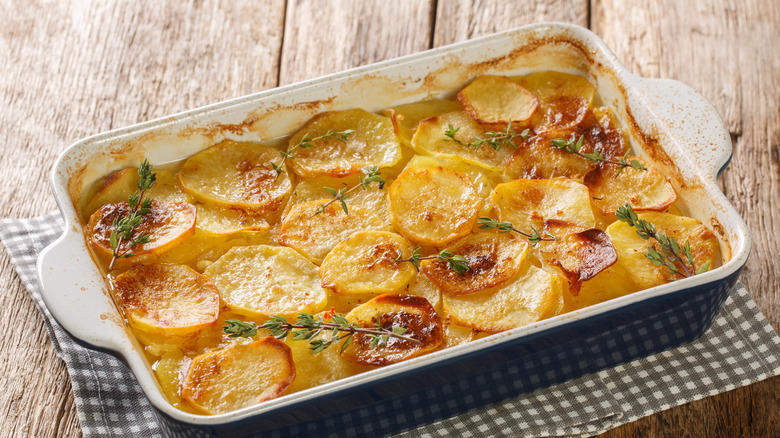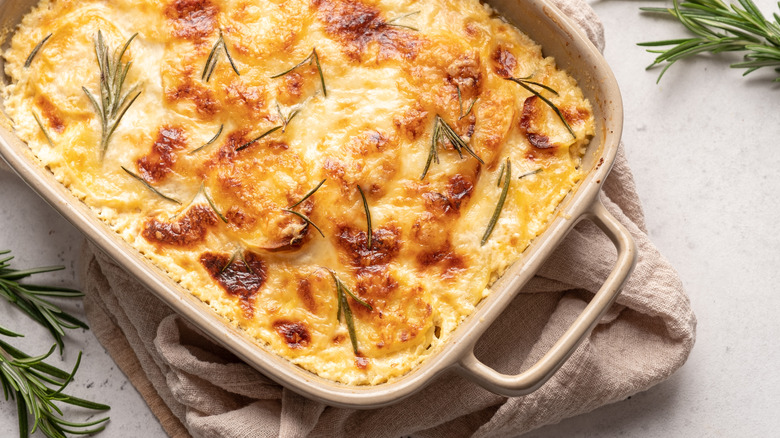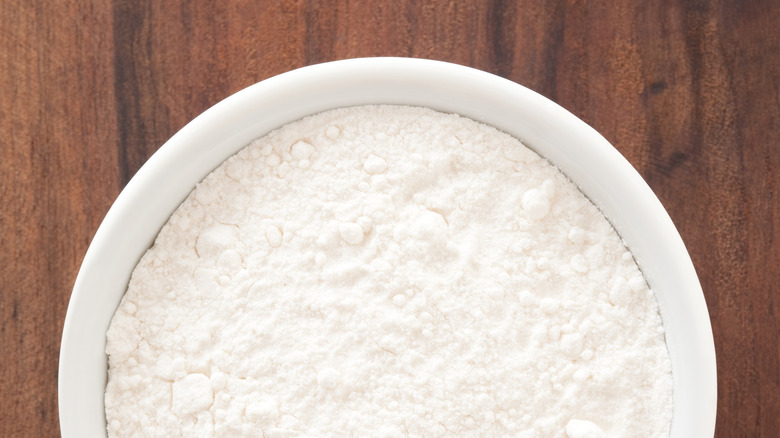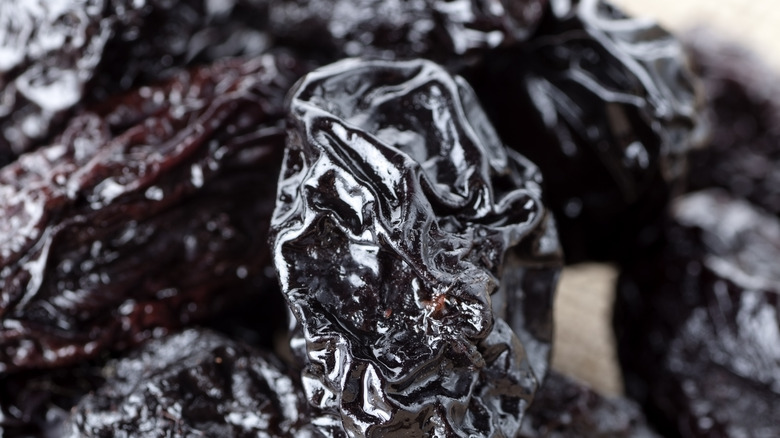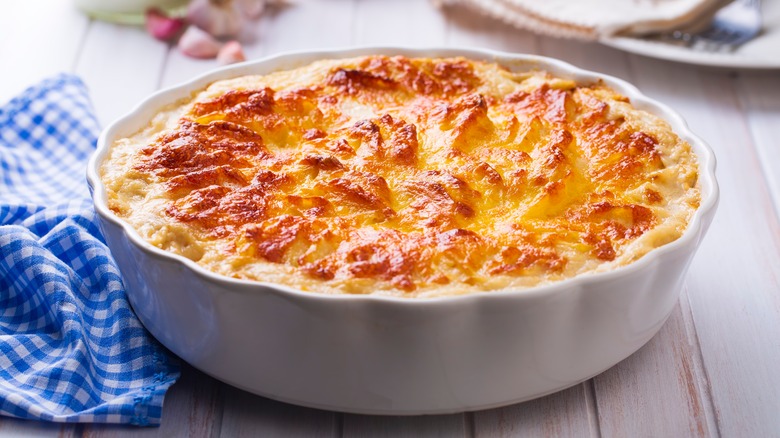12 Tips You Need When Making Au Gratin Potatoes
At most potlucks, you'll find at least a few pasta salads, deviled egg platters, and potato salads. It's hard to get away from them, and even if you enjoy those flavors, enough is enough already. There are, however, dishes that everyone prays will make an appearance. One of them is au gratin potatoes. Who doesn't love that cheesy, creamy, starchy casserole, loaded with cream, salt, and butter? And luckily, it's a fairly straightforward dish to prepare. However, there are a few ways to elevate your potato game, so we've broken down the most important tips you need when making au gratin potatoes.
For those of you who love a good potato casserole, you may be wondering what the key differences between au gratin and scalloped potatoes are, and you're not alone. The two look fairly similar to one another, as they both include layers of thinly sliced potatoes and cream. However, au gratin potatoes typically contain bread crumbs and cheese, while scalloped potatoes feature leaks. You might find that scalloped potatoes are sliced slightly thicker and that au gratin potatoes have a crispy cheesy topping. Don't get us wrong, both are to die for, but the preparation is different. So even if you make a killer scalloped potato dish, you may want to follow a recipe or brush up on the top tips when attempting to make au gratin potatoes for the first time.
Choose the correct variety of potatoes
Many of the important steps to making au gratin potatoes take place in the grocery store. This is where you will select your ingredients, and because the dish has many variations, it's important to choose wisely. There are plenty of potato options out there. You may be used to using primarily russet potatoes in your kitchen, but it's worth it to take a step back and consider your possibilities. In particular, it would be worth it to give Yukon gold potatoes a try.
Yukon golds are more tender, moister, less starchy, and sweeter than russet potatoes, which is why you should be baking with Yukon golds across the board. They are dense, creamy, and flavorful. Their skin and flesh are both light gold, as their name implies, and they have very thin and tender skin. In fact, because of this, you don't even need to peel them for au gratin potatoes unless you prefer an incredibly smooth dish. They are buttery once cooked, which helps to enhance the overall theme of the dish. If you're unable to find Yukon gold at your grocery store, don't panic. Any variety can work in au gratin, and the differences are subtle enough that your guests won't be disappointed. However, nobody could ever be unhappy with an especially starchy-smooth casserole.
Use a mandoline
If you're confident in your ability to make even and consistent slices of potato using a knife and cutting board, then more power to you. For the rest of us mortals, there are a few tools that can be quite helpful when slicing potatoes for au gratin. The most basic approach is to use a mandoline. Slicing potatoes and other casserole vegetables is one of the best uses for your mandoline slicer because it ensures consistent slices, which will inevitably cook more evenly. In addition, you can typically adjust the thickness of each slice on most madeleines. This will help to achieve the exact outcome you're hoping for in a dish.
For those who own food processors with a slicer attachment, you can opt to use power to do the work. Simply adjust the blade to your desired thickness, attach the metal slicer, and then top it with the plastic protector. Feed it one potato at a time, and use the plunger to gently guide the potatoes towards the rotating blade. Whether you use a handheld mandolin or electric method, target your ideal width below ¼-inch. This will help to create a dense dish that will still melt in your mouth. Without these tools, just be sure to take your time, use a sharp knife, and keep your slices as consistent as possible.
Select the right cheeses
Some recipes, especially those in the baking department, rely entirely on the cook to follow each step as stated. However, most casserole dishes leave a little wiggle room for the creator to add their own culinary magic. When it comes to potatoes au gratin, you can use many different kinds of cheese for highly varied mouthfeels, looks, and, of course, flavors. Typically, potatoes au gratin are made with Gruyère and cheddar cheese, which pair well together and create a delightfully creamy and gooey texture, but you're welcome to add other varieties or start from scratch with your favorite.
Cheddar cheese tends to be sharp, smooth, and very gooey when melted. Gruyère has a more mild, nutty flavor and is softer. Both can vary greatly depending on the region it's made, the production process, and the quality. For au gratin potatoes, we recommend using high-quality cheese for the best overall outcome. In addition to Gruyère and cheddar, you can use parmesan, mozzarella, and even goat cheese. Just be aware that the outcome will be altered in both flavor and mouthfeel. So, if you're looking for that traditional flavor, stick to the classics.
Layer the potatoes with cheese and seasoning
Any seasoned nacho maker knows that there's one important tip that makes for a particularly good batch. And it just so happens to be the same tip used for making the tastiest scalloped potatoes and au gratin: season each layer. There's nothing worse than a second mouthful of unseasoned, bland potatoes after an enjoyable scoop of melted cheeses and pungent, aromatic herbs. Consistency is key, so the distribution of cheese, cream, spices, butter, and potatoes is essential. This is why we don't simply pour au gratin sauce over a casserole dish filled with layers of potatoes; this kind of magic takes work and several intentional steps to accomplish.
When layering au gratin, be sure to start with a thin layer of cream and butter before adding a neat and uniform layer of overlapping potato slices. Each layer should include the cream sauce, as well as thinly sliced cheese. This will ensure that the dish holds together after it's baked and that each layer will be filled with flavor. If you're using herbs, spices, and aromatics, mix them into the sauce or sprinkle them between each layer. The breadcrumbs, however, are an exception. If you choose to include them, they can be used as a crunchy, crispy, buttery topping and don't necessarily have to be distributed throughout the casserole.
Include fresh herbs
An elite move for any home cook is to use fresh herbs in the kitchen. Yes, they are more expensive. And yes, you do have to pick them up fresh instead of storing them in the pantry or spice cabinet, but the difference is remarkable. Not only do freshly picked herbs taste incredible, but they can also add a pleasant aesthetic appeal and can be used as a garnish. Growing your own is the way to go if you have the resources, but most grocery stores will have fresh herbs available. When it comes to au gratin potatoes, there are several types of common herbs you can use.
Thyme is a classic. It's slightly citrusy and earthy. The leaves are small, so they don't need to be minced but instead stripped from the stem. Thyme pairs well with cheese and potatoes, so it's no wonder it does a remarkable job at flavoring au gratin. Rosemary is another pick that makes a pungent appearance quite often in the potato department. You won't need a lot to make a statement. Like thyme, it must be stripped from its stem before being layered into the casserole or used as a garnish on top. Parsley is famous for its popularity as a garnish; minced flat Italian parsley can add a light herbaceous undertone to your potatoes au gratin dish.
Don't skimp on the butter
There's a time and a place to go light on the calories and fat, but potatoes au gratin is not one of those times. A rich and fatty mouthfeel is what makes this indulgent food famous. For the plant-based, you can get away with using extra virgin olive oil and cashew cream in combination or vegan butter. For those who are cooking au gratin conventionally, there's no getting around this key ingredient.
Butter fanatics know that not all butter is created equal. Like cheese, fine wine, coffee, chocolate, and olive oil, butter comes in a variety of flavors and mouthfeels depending on the quality, production process, and the cows that produce the milk. There are many types of butter , and what they're used for varies. At a basic level, spring for salted butter for your au gratin potatoes. Unsalted butter is typically for baking; in this recipe, you'll want the seasoned flavor of salty butter. Cultured butter is another option which has a stronger and tangier flavor. The much fattier European butter works wonders because when it comes to au gratin, the fattier, the better!
Uses a deep dish
Some dishes are best when made thin and crispy, like pizza, and others that benefit from a deep dish like lasagna. Casseroles, in general, tend to vary in thickness. Still, there are some benefits to using the right dish and filling it with the correct amount of ingredients. Au gratin potatoes won't expand when cooked. If anything, the dish will condense. However, the cream sauce and cheese will bubble, so it's important not to fill your casserole dish up to the absolute brim. One of the best tips you need when making casseroles is to fill the dish just ¾ the way full and no more. You risk a soggy or undercooked casserole in the middle if you overfill the dish. If you layer it too thinly, you risk it drying out.
In addition, consider using a ceramic or glass casserole dish. Be cautious when baking a casserole in a metal dish — it won't hold its heat when served. Because metal heats up so quickly, you might notice the edges burn or crisp up much quicker than the middle as well. Then, heat dissipates. For a more consistent bake and longer serving time, avoid metal and stick to the pans your grandmother used.
Select full-fat heavy cream
Just as you don't want to skimp on the butter, it's also important not to use reduced-fat cream when making au gratin potatoes. And although there are many types of cream available, it's best to stick to what works best for the traditional recipe. For instance, a sour cream, light cream, or half and half just won't cut it. Stick to heavy cream, which is typically one of the fattiest creams. It contains over 36% butterfat, even more than whipping cream. Half and half aren't quite fatty enough, and sour cream has a distinct, zesty flavor.
If you must substitute heavy cream, use clotted cream, which has a slightly higher butterfat percentage, or whipping cream, which is slightly less fatty. Both, however, are fairly close and can get the job done. Be sure to use an unflavored cream without any added sugar. Cream and dairy products often have a slight, natural sweetness that will help create a balanced mouthfeel in the au gratin potatoes without the need for anything additional. The cream is important for cooking the potatoes into an irresistibly buttery soft bite.
Thicken it with flour
Some au gratin recipes call for a little flour to act as a thickener. Typically, this isn't an issue for gluten-free folks, as au gratin often contains breadcrumbs as well, making it an off-limits dish. However, there are other thickeners that you can use, like potato starch, as well as gluten-free bread crumbs for those who have celiac disease or gluten sensitivity. If your crowd can tolerate gluten, consider using it in combination with your heavy cream sauce to make an extra thick and delicious au gratin potato recipe. After all, it is the simple way to thicken anything from runny gravy to soup.
If you decide to include flour, ensure it's blended in well. Nobody likes clumps of flour in their casserole. Make a roux using some warm cream before incorporating it into the rest of the sauce. Use a whisk to break up any lumps. You can also use potato starch, but remember that a little goes a long way. This is a great way to avoid a runny sauce, but unless you really know what you're doing, be sure to follow a recipe. The only thing worse than a runny casserole is a dry one.
Think outside of the box
While there are standard ingredients out there that people tend to use when making au gratin potatoes, it never hurts to try something new. Of course, with experimentation comes caution, especially if you don't consider yourself an expert in this area of cooking. In order to find new and innovative methods of adding some pizazz to your au gratin potatoes, use inspiration from other cooks or from similar dishes. For instance, you can look up what herbs pair well with potatoes or what fruits pair well with Gruyère and cheddar cheese. Sometimes a small dash of nutmeg is added to cream-based recipes, so giving that a try wouldn't be totally out of left field.
Prunes are one surprising ingredient that will
. Those shriveled-up plumbs that folks use for digestive aid have a remarkably compatible flavor with the dish. They are sweet, with balsamic, chocolate, and molasses undertones that impart a modest caramelized flavor. They are also chewy, which develops texture and soaks up that melted cream sauce. In fact, as the casserole bakes, the prunes subtly infuse without overpowering. If you're just not sure about an ingredient that's off the beaten path, bake a mini dish of it alongside your standard recipe, do a taste testing, and decide if next time you'll want to give it a go in a full-sized pan.
Bake at the correct temperature
Casserole season means that our kitchens are filled with good smells, lots of cheese, and, of course, delicious leftovers for days. But part of their appeal to home cooks is how easy they are to throw together. A few wrong turns can result in a pile of soggy ingredients, but as long as you know the basics of making a casserole, you should be clear. One of the most important tips when making au gratin potatoes is knowing the correct temperature to cook it. Bake it too long, and the potatoes become mushy, and the cheese dries out. Take it out too soon, and it will be soupy with undercooked potatoes that are often bitter and slippery.
The most forgiving temperature range for cooking casseroles is between 300 and 400 degrees Fahrenheit. For au gratin potatoes, we prefer something between 350 and 375 degrees Fahrenheit so that the cheecan to crisp up on top, giving it that bubbly brown appearance. It should only take about 45 minutes maximum for those potatoes to cook fully. A butter knife can be used to test the center. If you can poke it through to the bottom without much resistance, then it's done. If this test causes the potatoes to shift around, give it more time.
Let the top layer of cheese crisp up
Both Gruyère and cheddar will crisp up when exposed to high temperatures. Unlike grated parmesan, they tend to melt beautifully. And there's a reason some cheeses melt much better than others. This typically has to do with age, as the water and fat tend to form a heartier bond that's less easily broken over time. You might even find that an aged cheddar melts less quickly than a newer one. For au gratin potatoes, you are looking for cheese to distribute evenly throughout the dish, but you also want that top layer to form a skin. To achieve this, consider adding your aged cheeses to the top of the dish, as they will be slower to melt and incorporate into all of those nooks and crannies.
If you're finding that the top of your dish just isn't becoming cratered with color but that your potatoes are nice and soft, try using the broil setting in your oven to finish it off. Keep the door propped open slightly and a close eye on your casserole. Wait until it just starts to brown, and remove it right away. If you plan on topping your casserole with bread crumbs, take into account that broiling it may burn them if they've been added early in the game.
